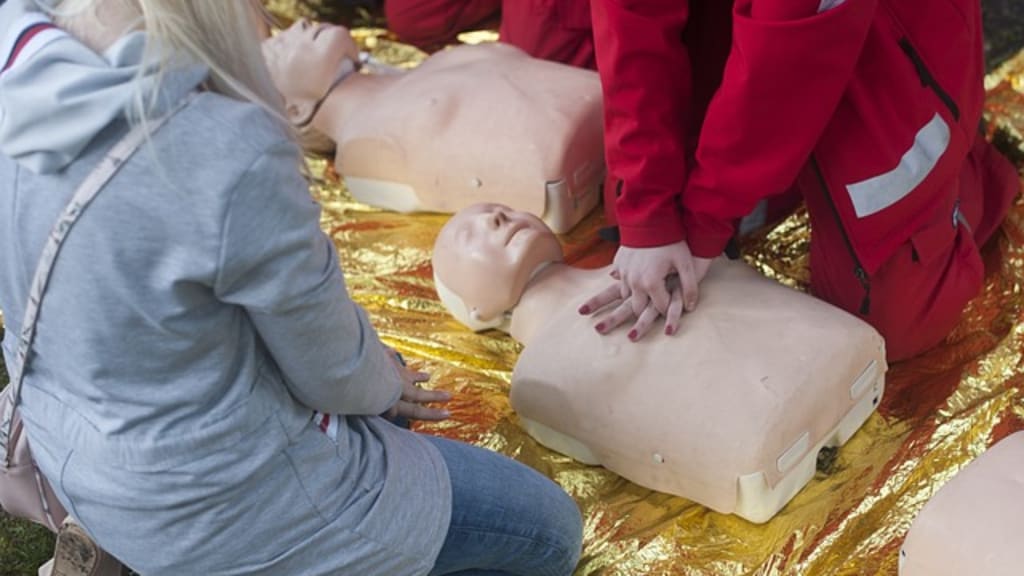
CPR or Cardiopulmonary Resuscitation is a life saving procedure performed when someone’s heart stops beating. CPR can double or triple the chances of the person’s survival following a cardiac arrest. If you are unsure or feeling scared to do CPR, just remember, it is always better to try and help a person stay alive than to do nothing at all.
Heart attack vs Cardiac arrest
-
Cardiac arrest
- Can occur suddenly and without warning and typically the person collapses and becomes unresponsive.
- It happens when the electrical malfunction causes the heart to stop beating unexpectedly.
- Heart is unable to pump the blood around the body and the person stops breathing normally.
- Cardiac arrest is an extremely serious health issue and likely to cause near-immediate death or disability.
- Immediately call emergency services and attempt to perform CPR while waiting for the medical staff to arrive.
-
Heart attack
- Also referred to as myocardial infarction usually happens when the coronary artery becomes blocked, blocking blood flow to the heart.
- Without blood flow, the affected heart muscles begin to die.
- Blood flow needs to be restored quickly otherwise the heart attack can cause permanent heart damage and death.
- Call emergency services and get the person to a hospital as quickly as possible
C-A-B
The American Heart Association (AHA) uses the letters C-A-B to help remember the steps of conventional CPR.
- C - Compression (Chest compression)
- A - Airway ( open the airway)
- B - Breathing ( rescue breathing)
CPR
- Check the area is safe for both you and the baby
- Check if the baby is responsive or unresponsive. Shout out the baby’s name to get the baby’s attention. Failing that, tap the bottom of the baby’s foot and shout again while checking for response or any change in condition. If the baby doesn’t respond in any way, then they are unresponsive and need to be treated asap. Do not spend more than 10 seconds trying to assess breathing.
- Get someone to call the emergency services as soon as possible. If you are on your own, call the emergency services and put the phone on speaker.
- Place them on their back on a hard surface like a table top or floor.. If the baby is on the bed, move them out and place the baby on a flat hard surface.
- To open the airway, place one hand on the baby’s forehead and very gently tilt the head back. Use the fingertip of your other hand to gently lift the chin.
- Remove the clothes from the baby’s chest.
- Giving breaths:
- Take a breath, put your mouth around the baby’s nose and mouth to make a seal.
- Blow gently and steadily for up to 1 second.
- The chest should rise and then fall when you stop blowing.
- Repeat this 5 times.
- If the chest doesn’t rise, perform compression only CPR
Performing Chest Compression:
- Place both thumbs side-by-side on the centre of the baby’s chest, just below the nipple line.
- The other fingers will wrap around the baby’s chest towards the back to provide support.
- Alternatively, use two fingers placed together on the chest
- Perform chest compression about a ⅓ of the chest depth or around 1 to 1.5 inches.
- Compression rate should be 100-120 compressions per minute. You can use the beat of the song “Stayin’ Alive” by Bee Gees to time your compressions
- Lift your finger slightly off the chest between compressions to allow the chest to come all the way back up.
Here is a video that demos how to perform CPR on an infant
AED
AED or Automated External Defibrillator are lightweight, easy to use portable electronic devices that can analyse the heart’s rhythm and help reset abnormal rhythm if possible. AED gives visual or voice prompts to guide you through what steps to follow and give the best chance of improving the chance of survival for a person having a sudden cardiac arrest. Read our guide on how to use an AED on an Adult, child and infant.
Raising awareness
If you are a new parent or know a new parent within your family or with your workplace you can:
- Watch how to do CPR for infants video and share it with friends and family - those couple of minutes can save a life.
- Gift a CPR anytime infant kit to a new parent.
- For new parents, try to learn about CPR for infants and dealing with any other common emergencies before you leave the hospital with your new baby or sign up for a course as soon as possible.
Disclaimer
This post may contain affiliate links which means we may receive a commission at no extra cost to you should you click through and make a purchase.
Note: please check the ingredients list of any products that you may wish to try and check for allergies or consult a medical professional for any existing conditions being impacted by switching to new products.
Attribution
Banner Image by Andrzej Rembowski from PixabayPrevious

21-11-2023
Guide to tracking and monitoring your periodsLearn how to track and monitor your periods to make
Next

12/12/2023
CPR: guide to performing CPR on teens and adultsLearn to perform CPR on teens and adults and things to consider while dealing with someone who has gone into cardiac arrest.